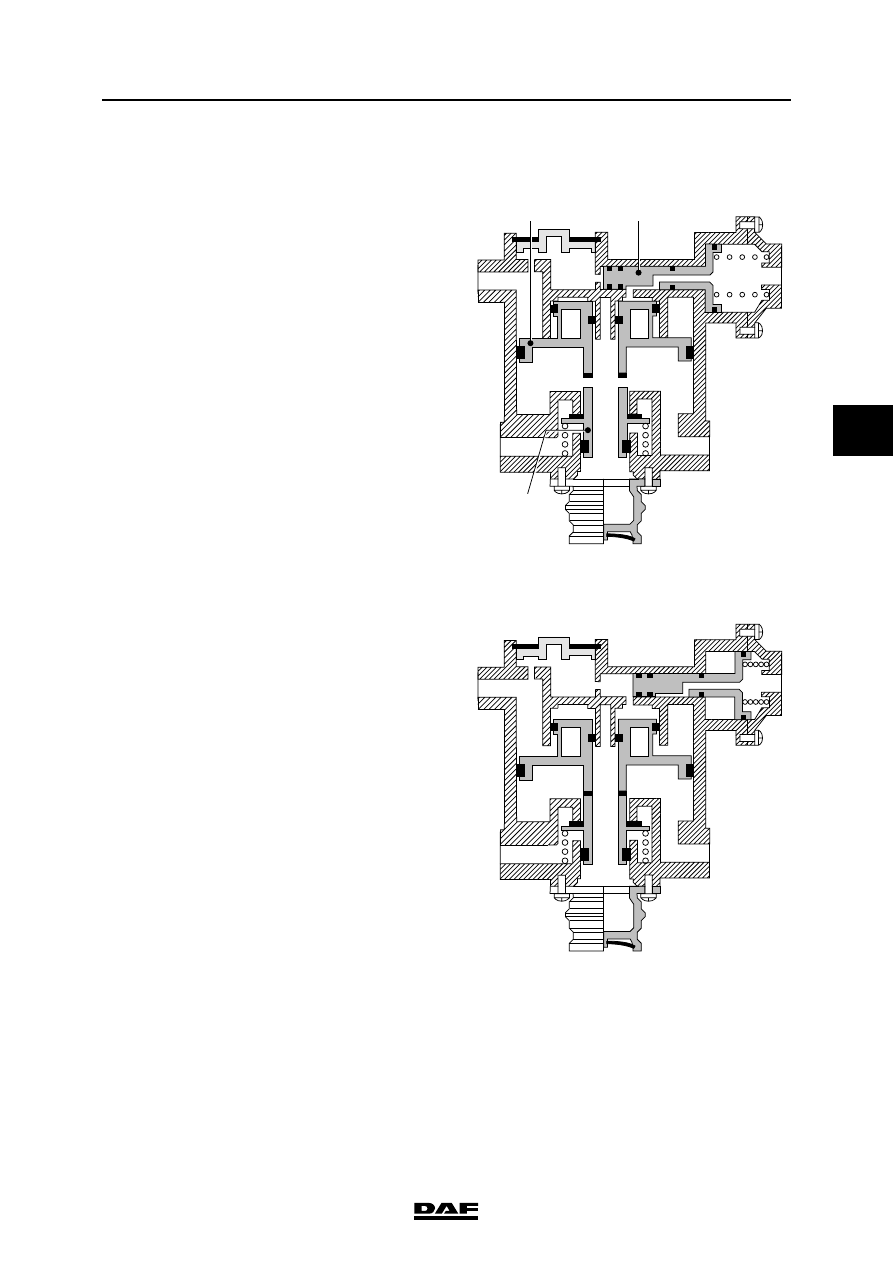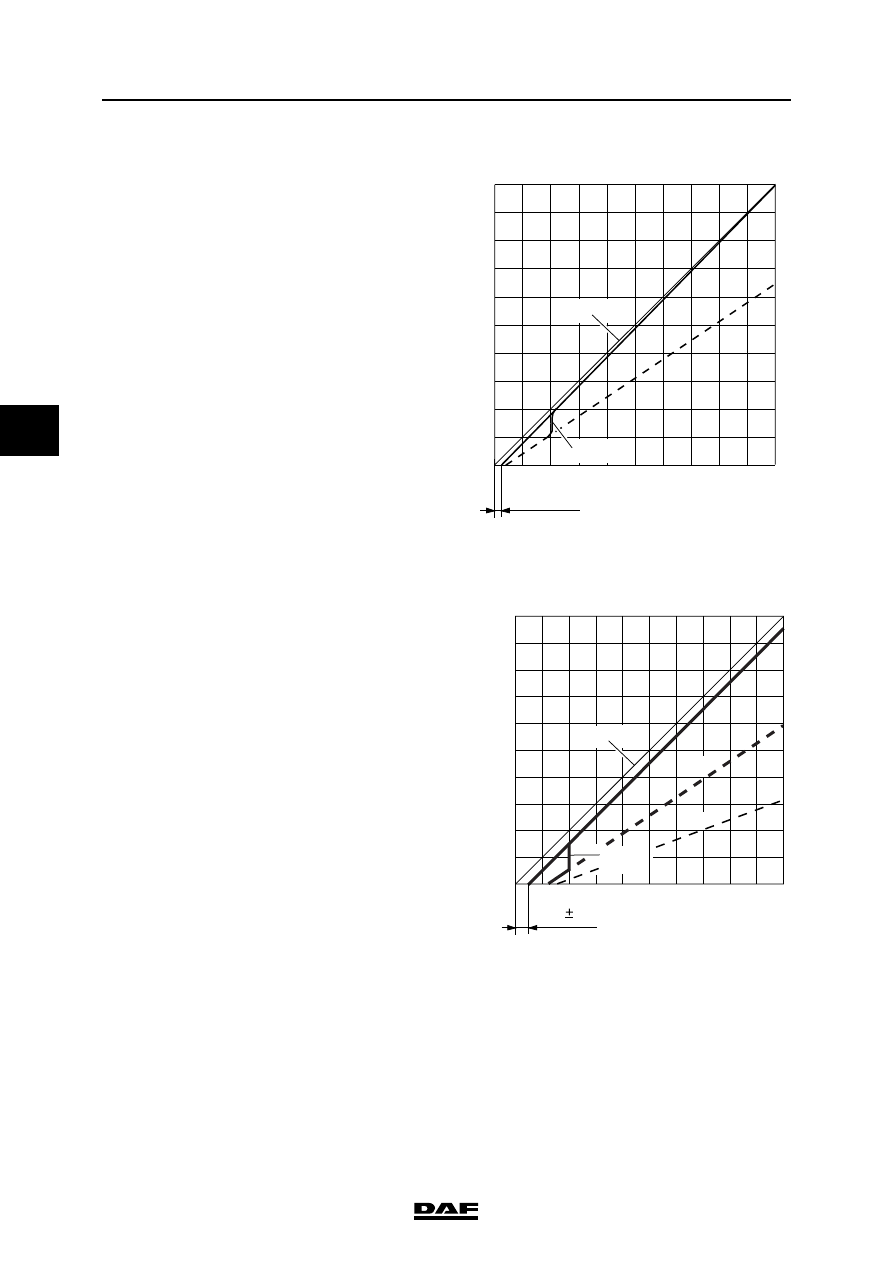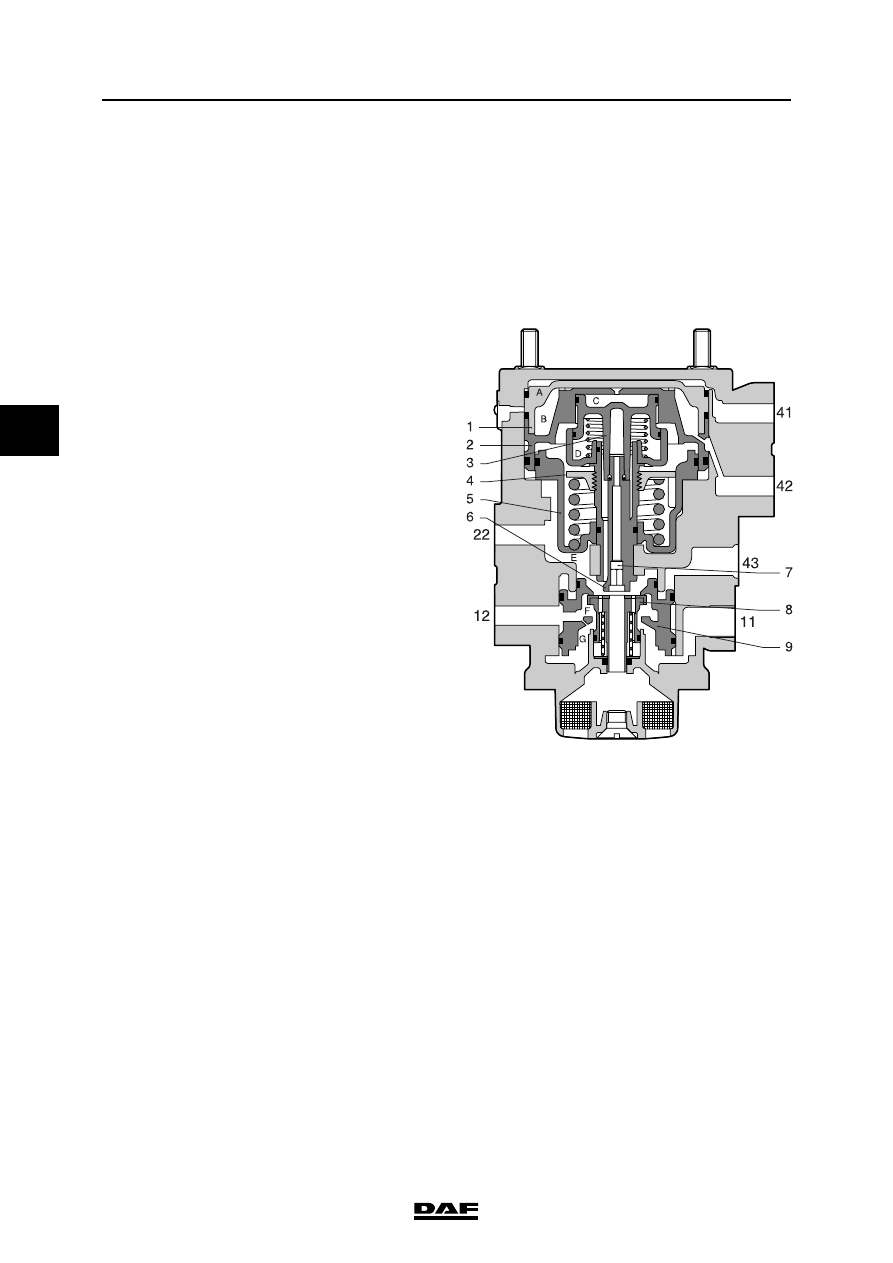DAF LF45, LF55 Series. Manual — part 457

©
200436
2-7
Inspection and adjustment
BRAKE SYSTEM AND COMPONENTS
ΛΦ45/55 series
6
4
2.5 INSPECTION EMPTY/LOAD RELAY VALVE
1.
Using a T-piece, connect a pressure gauge
to connecting point 41.
2.
Connect a pressure gauge to the test
connection on one of the brake chambers of
the front axle.
3.
Connect a pressure gauge to the test
connection on one of the brake chambers of
the rear axle.
4.
Pressurise the system.
Testing when empty
1.
Set the load sensing valve to the empty
position.
2.
Slowly depress the brake pedal.
The pressure on the front axle should rise
gradually, not in jumps.
The pressure on the front axle will rise less
quickly than that on connecting point 41.
(With an empty vehicle, the difference will be
greater than with a partially loaded vehicle).
1
2
3
42
41
R600904
4
6
5
1
2
3
42
41
R600905

BRAKE SYSTEM AND COMPONENTS
2-8
©
200436
Inspection and adjustment
4
ΛΦ45/55 series
6
Testing when fully loaded
1.
Set the load sensing valve to the full-load
position.
2.
Slowly depress the brake pedal.
The pressure on the front axle should rise
gradually, not in jumps.
The pressure on the front axle will rise as
quickly (approx. 0.2 bar) as that on
connection point 41. It must be possible to
approximate the system pressure.
Inspection when faulty
1.
Disconnect the pipe to connecting point 42
and plug off the pipe.
2.
Repeat point 8.
3.
Set the load sensing valve as specified.
4.
Reconnect the pipes to points 41 and 42 in
the original manner.
5.
Remove the pressure gauges.
Inspection, output pressure to the front axle
1.
Measure the rear axle load.
2.
Check the load sensing valve setting.
3.
Connect a pressure gauge to the test
connection for the load sensing valve (input
pressure) and a pressure gauge to the test
connection on the brake cylinder of the front
axle.
4.
Make sure that the reservoir pressure
exceeds 6.5 bar.
5.
Depress the brake pedal until the pressure
gauge on the test connection of the load
sensing valve reads 6 bar, and read off the
braking pressure on the pressure gauge of
the front axle.
6.
Compare this value with the data in the table
attached to the door pillar.
0
0,1
0,25
1
1
2
2
3
3
4
4
5
5
6
6
7
7
8
8
9
9
10
10
+
_
R600906
P
0
42
=
P
42
P
41
=
0
0,1
0,5
1
1
2
2
3
3
4
4
5
5
6
6
7
7
8
8
9
9
10
10
P
0
42
=
P
42
P
41
=
1:2,7
1:1,5
41(bar)
p
2(bar)
p
R600745

©
200436
2-9
Inspection and adjustment
BRAKE SYSTEM AND COMPONENTS
ΛΦ45/55 series
6
4
2.6 INSPECTING THE RELAY VALVE
Inspecting the relay valve
1.
Connect a pressure gauge to connecting
point 4 of the relay valve.
2.
Connect a pressure gauge to connecting
point 2 of the relay valve.
3.
Pressurise the system.
4.
Depending on the position of the relay valve
in the brake system, slowly activate the
service brake or parking brake.
5.
The pressure in the pressure gauge
connected to connection point 4 must now
increase to approx. 0.8 bar (the increased
parking brake actuating pressure) or 0.5 bar
(service brake), without there being any
noticeable pressure on connection point 2.
From this point, the pressures in both
pressure gauges must increase identically.
The pressure on the gauge connected to
point 2 should not rise in jumps. Both gauges
should indicate a value corresponding to the
graph. See "Technical data".
R600490
2
1
6
4
A
5
3
7

BRAKE SYSTEM AND COMPONENTS
2-10
©
200436
Inspection and adjustment
4
ΛΦ45/55 series
6
2.7 INSPECTION, TRAILER VEHICLE CONTROL VALVE
1.
Ensure there is sufficient system pressure.
2.
Check whether air is escaping via the bleed
vent.
3.
Depress the brake pedal, and again check
for leaks.
4.
Disconnect the pipe at connecting point 42
and plug off this pipe.
5.
Depress the brake pedal, and check for
pressure build-up in the service pipe (see
"Technical data").
6.
Reconnect the pipe.
7.
Repeat the last three points, but now for
connecting point 41.
8.
Operate the parking brake: pressure should
build up in the service pipe (see "Technical
data").
9.
Operate the parking brake to the stop, and
lock the lever: the service pipe should once
again become pressureless.
10. Simulate a leak in the service pipe, and
depress the brake pedal; within two seconds,
the outflow of air from the leak should slow
down considerably.
R600340

Нет комментариевНе стесняйтесь поделиться с нами вашим ценным мнением.
Текст